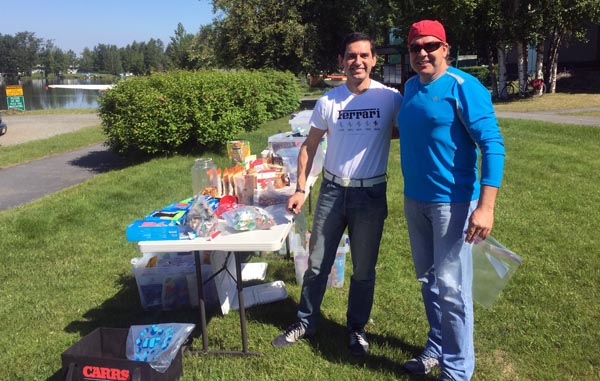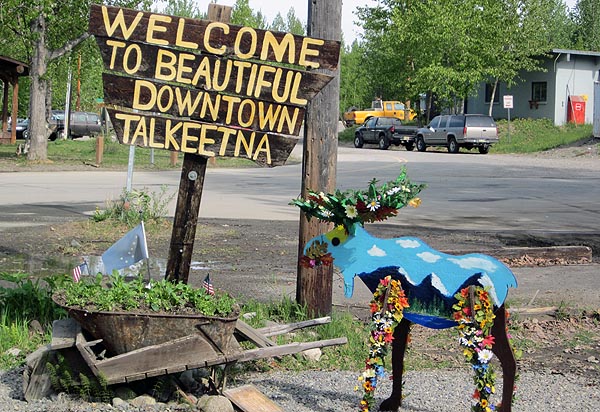THE TALKEETNA HANG
by Dave “hangdog” Staeheli
Here is the problem. We are dependent, or some might say, whores to the weather. It doesn’t matter our intentions, mother nature is the boss, and if she says, “you ain’t going to do that,” you aren’t going to do that. This can plague us our entire trip if unlucky, but nothing is more frustrating than hitting Talkeetna raring to go, and then… nothing. Base Camp is socked in and the planes aren’t flying. Or it is pouring rain in Talkeetna and the ceiling is on the deck, or the pilots report severe icing and they can’t fly. But we have this schedule! We are ready to go NOW! What to do now?
Well first of all, let’s not waste a good panic. As a guide, I’m first thinking of this as an opportunity. With all the packing, travel and briefings, it has been tough to get a good breath in. If we had flown straight in, we would still be on the hustle until we got out to Ski Hill, a full day up the route. Getting on the route is a lot simpler. Get up in the morning, eat, climb, eat, kick back, eat, eat, eat and then sleep. If it is stormy, replace climb with more sleep. So if we can’t fly, step back, take a deep breath and remember that this is arctic, high altitude mountaineering! Rarely do things go according to plan. Someone once asked that prolific climber of Alaska Mountains, Jack Tackle, how to climb in Alaska. He said, “Buy a plane ticket to Alaska, a roll of duct tape, and everything else will sort it self out”. Or as our inestimable leader Todd Rutledge will say, “be rigidly flexible.” There are always things we can do to advance ourselves in the big picture.
One of those things is that we have quite a number of briefings, or “schools” we can do just as easily in Talkeetna as on the glacier. One or two of them are actually easier to do in Talkeetna. These briefings cover such mundane subjects as sled and pack rigging, tent erection and camp building, travel practices and crevasse crossing, aspects of high altitude arctic mountaineering, as well as less pleasant, but for some reason always entertaining, subjects like how to use a CMC can. Expect to hang from a rope thrown over a roof beam in the shelter at Talkeetna Air Taxi as if you were in a simulated crevasse. Get these schools out of the way and then when we finally do fly in, we can hit the glacier running. Well, maybe not “running,” but you get the picture.
Unfortunately, about once or twice a season Mountain Trip has a team that is shut down in Talkeetna for more than a day or so, which is about how long your guides can stretch their briefings. Welcome to the “Talkeetna Hang!”
You can’t really be an Alaska climber until you spend time hanging out in Talkeetna waiting for the weather to clear. This is what is known as “full value!” It’s time to really get into it. Most climbers really never get to experience Talkeetna, which in my opinion, is a really cool town. Early season before the tourists arrive, the local wildlife has to be seen to be believed. Some of them aren’t even climbers! Yes sure, check out the museum and get some ice-cream at Nagley’s, but the experienced Alaska climber packs an extra book in their luggage for an eventuality like this. Go to the Roadhouse for breakfast and order the “Full” rather than the “Half” breakfast for a gastronomical overdose. Check out the Fairview Inn for a beer or two, but caution, every season I have a climber or two who spends their first day on the glacier with a hangover. Brutal! Watch the experienced Alaska climbers and do what they do. No panic, it is just part of the game, and probably doesn’t change the results in the big picture anyway.
What you do need to do though, is stay close or in touch. The weather can break at unexpected times. Usually the first plane into base camp handles 7 or 8 climbers, and if we are first on the list, we want to fill every seat. If that plane makes it in, then there is a massive launch of planes and climbers towards base camp. If the weather holds, no worries, Talkeetna Air Taxi will get everyone in. Last season after a five day shut down (not a record, but pushing it), TAT flew 110 climbers into base camp in one day! If there is any chance of a flight that day, we usually keep a guide on short leash to the air taxi. Please let your guide know where you are going and how to get you back to the airstrip pronto!
If you are forced into the Talkeetna Hang, be patient, keep your spirits up, relax and realize it’s all part of the Alaskan mountaineering expedition game. For many of you, this might well be your only Alaskan trip; enjoy it for what it is.




